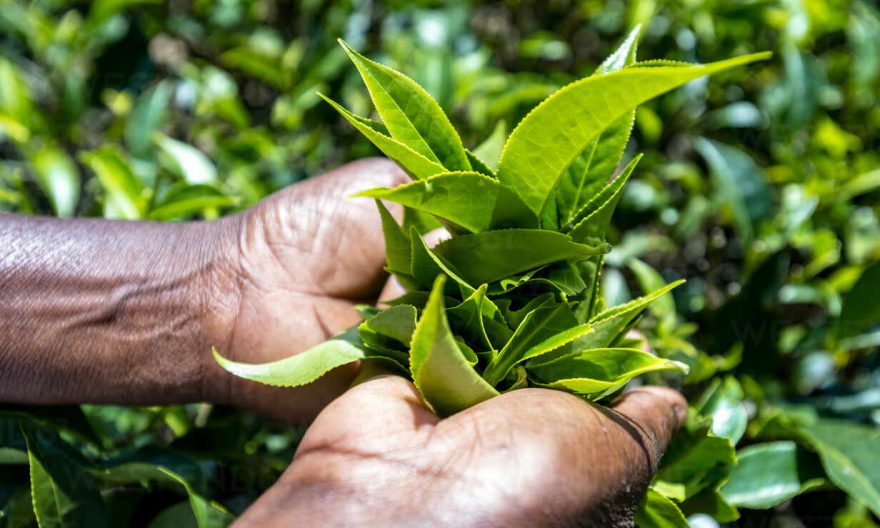
BY GETACHEW MINAS
Tea is one of the most consumed beverages in the world and was first used in China for medical properties centuries ago. There are two recognized varieties or groups referred from their origin as Assam and China. These varieties of tea differ in features and quality. As far as the Western tea trade is concerned, Assam has been regarded as producing the best fermented tea. In recent years, however, hybrids of the two varieties have also been found to be high quality fermented tea. Legends, and most sources, acknowledge the Chinese Emperor Shen Nung (28th century B.C.) for the discovery of tea. The tea plant originated in South-East Asia, probably in the region incorporating high valleys separating India, China and Burma. The Chinese are familiar with tea leaves, which they used in vegetables and medicinal compounds.
The tea leaves had never been considered an ingredient of a hot, refreshing drink. Historically, the cultivation of tea plant in other countries was started at different time. In the late 17th century, tea became a popular beverage served in numerous tea houses in London. Its popularity was rapid and today it is the most widely consumed beverage in the world next to water. The botany of tea plant shows that when left un-pruned, it grows in to a small tree with a conical shape. In cultivation, it is pruned to form a hedge of convenient height for hand plucking or machine harvesting. Much of the tea produced in tropical countries is grown on steep hillsides at high elevations. The tea shrub is a perennial evergreen plant.
There are other varieties in addition to the previous two types of varieties. These varieties differ in the height of the tea bush, the number of stems and characteristics of their leaves. Leaves are produced alternatively on branches. The leaves have a fine margin. All tea leaves are somewhat shiny and they contain thickened cells. These are of importance in the tea-trade because their presence in the prepared tea determined its quality. With the tea crops, leaf growth is of central importance because the leaves provide the yield. Tea blooms at regular frequency which is not strongly related to climatic changes, though the quantity of leaf produced is greatly affected by rainfall and temperature as well as by nutrition.
The frequency of picking and plucking depends on its blooming and growth rates. It will vary from one to two weeks in tropics, during the period of blooming. In general, two leaves and a bud are the ones to be plucked to ensure quality. It is very important for continued production “not” to pluck the mature leaves below this, which are called maintenance leaves. Climate and soil characteristics are the most important ecological factors in growing tea. The variety of the plant is also another factor in growing tea. For instance, the Assam variety is less hardy than the China variety, which can tolerate a longer dry season or lower temperature. It grows under a variety of climate conditions from the humid tropical lowlands to regions of high latitudes. In tropical countries, tea leaves are harvested all year around.
In temperate countries, harvesting is seasonal. There are many different kinds of products of different quality arising from different cultivation practices, growing conditions and processing methods. Application of fertilizer is also important for the growth of the tea plant and the quality of the black tea leaves. The failure to apply fertilizer resulted in depletion of the organic matter from the soil. There are several major categories of tea, which are distinguished by different processing methods and, consequently, different concentrations of the chemical components in tea. Depending on the degree of fermentation prior to further heating and processing teas are categorized in to three major varieties: green tea, oolong tea and black tea.
The green tea is a yellow to green color which is preferably manufactured for market. Its chemical constituents are not altered by fermentation. In general, it does “not” involve the withering processes as well as fermentation. The oolong tea is a semi-fermented tea which is manufactured by letting the tea leaf to undergo incomplete fermentation. It has large twisted leaf, brownish in color with white tips, produces a light green, slightly coppery tea. Its chemical composition is in between the green tea and the black tea. The black tea is a completely fermented tea leaves. Fresh tea leaves are rich in compounds.
When tea leaves are intentionally broken or rolled during processing the compounds become oxidized. This is known as “fermentation” in the tea industry. Fermentation causes them to form larger, more complex compounds. This brings a difference in the color, aroma and chemical composition of the black tea as compared to green tea and oolong tea. In fact there are “other” two types of tea, the white tea and yellow tea that have been regarded as two subclasses of green tea. These two types of tea are different from green tea due to differences in variety, processing, geographical and traditional distributions.
The production of tea-leaves in Ethiopia has got a history of more than half a century. Nevertheless, it is about four decades since the consolidated and organized development of tea production began. The production of tea-leaves was begun in 1984 with the support of the state and not more than 2,000 hectares were produced. In Ethiopia, tea is mostly grown in the highland dense forest regions where the land is fertile and thus the use of “fertilizer” is very minimal. Moreover, the availability of abundant and “cheap” labor in the country has made the use of manual weeding, instead of chemical weeding, possible. Because of this mostly organic cultivation, Ethiopian tea is increasingly “sought” for its aroma and natural flavors. Tea is grown in Wush Wush, Gumaro, Gimbo, Ale Dido, where tea plantations are known for their aroma.
Tea was commercially available in the local country markets, suggesting that tea processing and marketing was widespread. Studies show that tea is one of the most consumed beverages in the world with an estimated 18-20 billion cups consumed daily. The principal types of tea produced and consumed in the world are black and green teas, with small amount of other types. Black tea represents approximately 78 percent of total consumed tea in the world, whereas green tea accounts for approximately 20 percent. The major producers of tea are also the major consumers. During the 1990s, the world production and consumption of tea has increased steadily with occasional fluctuation in some years. Thus, black tea has become a very important agricultural and commercial product, with Kenya as the third largest producer and exporter of black tea. Ethiopia also exported teas regularly to different countries.
The chemical components in black tea have a health benefit to humans. Studies suggest that tea is protective against certain cancers, cardiovascular and neurodegenerative diseases. The total level and activity in black tea is similar to green tea. Both types of teas are used in folk medicine for headaches, body aches and pains, indigestion, immune defenses, and detoxification. In the process of black tea manufacturing, the green, glossy leaves and young new leaves are plucked and immediately processed for optimal freshness. The first step in the manufacturing of black tea is withering, which removes a large proportion of the water from the fresh leaf by evaporation.
After evaporation, the leaves become limp and suitable for rolling and undergoing fermentation. Rolling consists of twisting or breaking up the leaves for preparing them for fermentation. They are transformed into particles corresponding to the type of commercial tea required. Fermentation is the most important stage in the manufacture of black tea. It involves fermentation which converts leaves from green to copper brown color. This process leads to the formation of chemical compounds which give the characteristic color and taste of black tea. Fermentation reduces the water content of the tea which makes handling and transportation easy. Then the tea will be packed after sorting, which consists of extracting the fibers with the aid of winnowing machines and grading the tea by size and weight.
The chemical composition of tea may vary depending on different parameters such as the variety of leaf, growing environment, application of fertilizers, manufacturing, particle size of ground tea leaves and infusion. Tea leaves contain many compounds, such as volatile oils, vitamins, minerals, and alkaloids. Although all three types of tea have antibacterial activities, the “efficacy” decreases substantially when the tea becomes darker. Proven medicinal properties include antioxidant, anti-inflammatory, anti-allergic, antibacterial and antiviral effects. They also have the ability to strengthen veins and decrease their permeability. It is widely believed that the anti-oxidizing effects of both black and green varieties are “reduced” when taken with milk. However, a recent study concluded that it is not affected by milk.
Tea appears to be the most potent therapeutic plant, aside from its antiseptic and antioxidant properties. It is able to form compounds with other molecules, thereby detoxifying the system. A recent study by du Toit et al showed that black, green and oolong tea are all extremely good sources of vitamin C. The researchers found that one or two cups a day “provide” the equivalent of three glasses of orange juice. Among the characteristics of a good cup of black tea are red or rosy in color providing briskness without bitterness. The chemical entities in tea are generally believed to cause variations in color and bitterness. The quantities are said to determine both the color of the tea beverage. A tea with an optimum level of each of the chemical groups may give a tea infusion with a rosy color and appropriate briskness.
Tea is one of the commercial products of Ethiopia. It mainly grows in the Western part of the country in Gumaro and Wush Wush, which are the two oldest and biggest tea plantations in the country. It is believed that the British Council General in Gore (operational during the time) obtained seeds from India and distributed them to local farmers. Then in 1957, a Lebanese expatriate in cooperation with a Belgian, expanded his tea estate. In 1981, the government expanded and developed it planting eucalyptus to provide fuel for drying tea in the factories. Gumaro and Wush Wush were sold to Ethio Agri-CEFT, which conducts the final sorting, blending, grading, cup tasting and packing of the tea in Addis Ababa.
Currently, the company is packing three brands of black tea (Gumaro, Wush Wush and Addis) in small packages. Some of the products of Agri-CEFT include green label, red label, gold label, with tastes of herb, ginger, mint, cinnamon and green tea. The other major tea brand in Ethiopia is “Good Morning/Ahadu, which is packed by East Africa Holding. Tea production at the moment has created jobs for several thousands of people mainly in the farms. Tea export generates foreign exchange to Ethiopia, also playing key role in import substitution.
Thank you.
THE ETHIOPIAN HERALD JUNE 17 /2021




